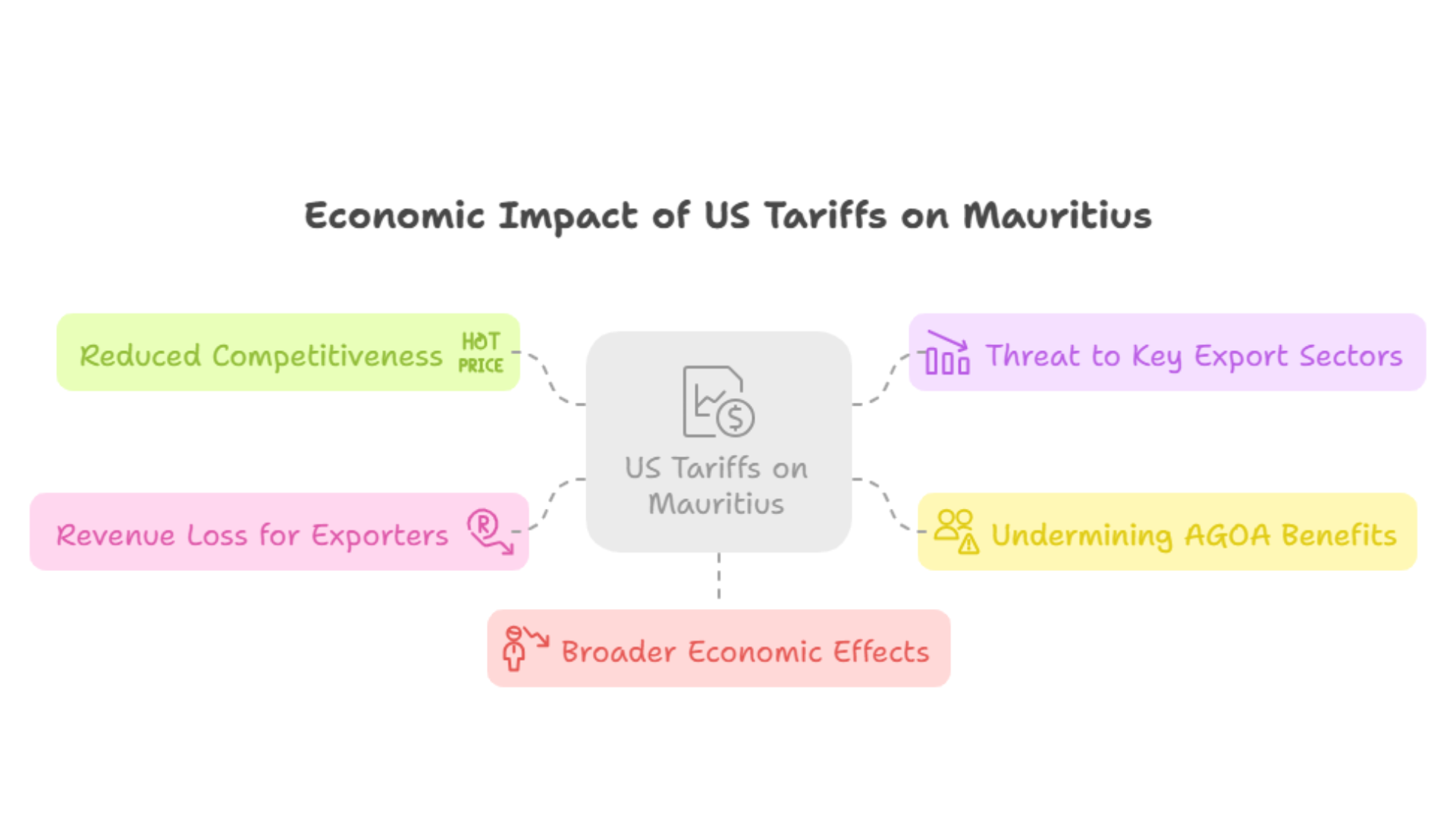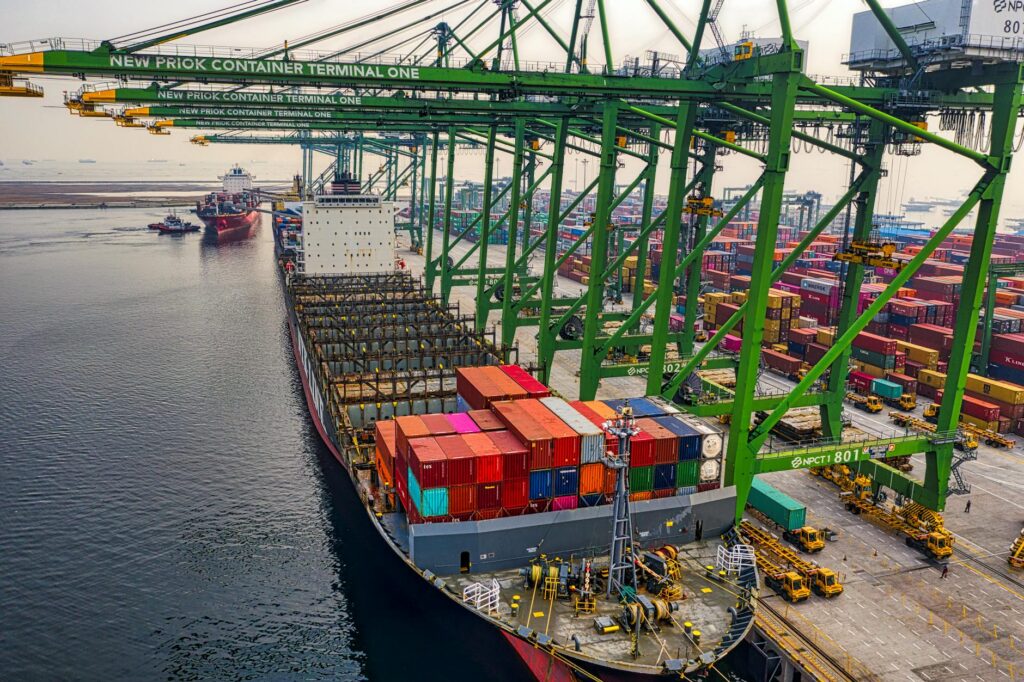The 40% US Tariff on Mauritian Exports: What’s Really at Stake?
On April 2, 2025, the United States shook global trade by imposing a steep 40% tariff on imports from Mauritius—quadruple the new baseline rate applied to most countries. Framed as part of an “economic emergency,” this move threatens not just Mauritius’s key export sectors, but also its long-standing preferential trade ties with the US.
With concerns rising over job losses, revenue drops, and supply chain shocks, the implications are far-reaching. So, how did we get here—and more importantly, what does Mauritius do next? Let’s break it down.

Understanding the Tariff Breakdown
The recent 40% US tariff on Mauritian exports has raised alarms across business circles and government corridors. But what exactly does this tariff mean—and how is it different from the baseline import duties being applied to other countries?
Let’s break down the numbers, the rationale behind them, and why this one-size-does-not-fit-all approach is especially concerning for Mauritius.
The Baseline Tariff vs. the 40% Shock
On April 2, 2025, President Donald Trump announced sweeping tariff reforms under what he declared as “Liberation Day” for American industry. As part of this move, the U.S. imposed a 10% baseline tariff on all imports, effective April 5th. This was meant to “restore fairness,” stimulate domestic manufacturing, and reduce the U.S. trade deficit.
However, Mauritius didn’t just get grouped into the global tariff regime. Instead, it was singled out with a steep 40% import tariff, one of the highest applied to any country. According to reports from DW and CNBC, this country-specific rate was justified as a “reciprocal measure” based on the trade imbalance between the U.S. and Mauritius.
While a 10% duty already complicates pricing and competitiveness, a 40% tariff creates a near-immediate barrier to market entry for Mauritian goods.
Why Mauritius? And Why Now?
Mauritius accounts for only 6.2% of its total exports going to the U.S. (2024 figures), so the volume might not seem threatening to American producers. However, the products it exports—textiles, sugar, seafood, and processed goods—have traditionally enjoyed duty-free access through the African Growth and Opportunity Act (AGOA).
According to the Mauritian Prime Minister, “Being an AGOA-eligible country, Mauritius has been benefitting from duty-free market access for some 6,400 product lines on the US market.” The sudden imposition of tariffs undermines those benefits, essentially putting Mauritian exporters back at square one.
From the U.S. perspective, the tariff is framed as part of a broader economic reset—to pressure countries perceived to have unfair trading advantages and reassert domestic production priorities. Yet for small, trade-dependent economies like Mauritius, such moves feel disproportionate and disruptive.
What’s “Reciprocal” About It?
The U.S. government has described these tariffs as “reciprocal,” meaning they are designed to mirror the trade barriers that other countries impose on American goods. But here’s where things get murky.
Mauritius is a developing economy with relatively low tariffs on U.S. products and active participation in trade liberalization agreements. Applying a 40% tariff under the umbrella of reciprocity raises concerns of economic bullying rather than fair rebalancing.
According to CNBC and DW, the U.S. administration insists that these individualized tariffs are about addressing longstanding imbalances. But the numbers suggest that Mauritius was more collateral damage than a genuine trade threat.
A Temporary Window for Talks?
In a small gesture of flexibility, the White House did announce a 90-day pause on reciprocal tariffs, offering countries like Mauritius a chance to engage in direct negotiations. The Mauritian government has already responded, stating that it will initiate dialogue with U.S. officials, explore a potential bilateral trade agreement, and raise the issue at the African Union level.
This period offers a critical opportunity—not just to lower the tariff rate—but also to restore trust and predictability in trade relations that have long supported small economies.
How the 40% Tariff Threatens Mauritius’s Key Industries
The 40% US tariff on Mauritian exports isn’t just a number—it’s a wave that could ripple through the backbone of the Mauritian economy. While the overall volume of exports to the US may seem modest, the tariff’s impact on specific industries is anything but small. If you’re involved in manufacturing, agriculture, seafood, or textiles, the effects will be felt faster than you might expect.

Fig 1.0 USA Tariffs and its economic impact on Mauritius
This section takes a closer look at the most vulnerable sectors and how they’re likely to fare under the pressure of the new trade policy.
Textile and Apparel: From Strength to Strain
The textile and apparel industry is one of Mauritius’s top export earners, and it has historically benefited from duty-free access to the US under the African Growth and Opportunity Act (AGOA). This preferential treatment allowed local manufacturers to stay competitive in a global marketplace dominated by low-cost producers.
Now, that edge is at risk. According to government statements reported in CNBC, the 40% US tariff on Mauritian exports could lead to immediate cost hikes that make Mauritian garments significantly more expensive for American buyers. That means lower demand, shrinking orders, and possible layoffs in textile factories that employ thousands.
You might already be seeing early warning signs—reduced purchase orders, payment delays, or increased price sensitivity from US retailers. These are not isolated incidents but a reflection of how a sudden tariff can squeeze even the most stable trade relationships.
Sugar and Specialty Agriculture: A Bitter Outlook
Mauritius has long prided itself on its premium sugar exports, including specialty and organic products highly valued in the American market. However, that pride is now met with serious concern.
The new 40% tariff will significantly erode the competitive pricing of these goods. According to the Prime Minister’s address, this sector may experience a direct revenue loss as buyers seek alternatives elsewhere—often from countries not subjected to such high tariffs.
And it’s not just sugar. Other specialty products like exotic fruits and value-added agricultural items also fall into the same risk zone. If you’re part of this sector, it’s essential to explore regional export opportunities within Africa or establish niche branding that justifies premium pricing despite the tariff burden.
Manufacturing: Stuck in the Middle
The manufacturing sector in Mauritius has evolved over the years—from basic assembly lines to more advanced, value-added production. Much of what is exported to the US, however, falls under categories now affected by the 40% tariff.
Unlike textiles or agriculture, manufacturers often operate on thin margins, and pricing flexibility is limited. The cost of raw materials, labor, and logistics already eats into profits. Add a 40% tariff on top, and you’re looking at deals that simply don’t make sense anymore.
According to the Mauritian government, small and medium-sized enterprises (SMEs) will be hardest hit. Without the resources to quickly shift to new markets or restructure operations, many may face financial strain or closure.
Not All Sectors Are Equally Vulnerable
Interestingly, not all exports are expected to suffer equally. As outlined in the government’s latest trade briefing, 52.8% of Mauritian exports to the US are considered inelastic, including items like polished diamonds and live animals used in scientific research. These goods are less sensitive to price changes and may continue to flow with fewer disruptions.
However, inelastic goods are only part of the picture. The broader risk to job-rich, labor-intensive sectors remains a serious concern. If you’re in any of these at-risk industries, the time to act is now—whether through lobbying for government support, seeking new trade partners, or adapting your business model to survive the new normal.
How Exporters Are Responding
The 40% US tariff on Mauritian exports didn’t just land like a policy memo—it hit like a shockwave. And while the immediate reaction may have been disbelief, exporters across Mauritius are now shifting gears and mapping out survival strategies. You’re seeing the start of an urgent pivot—one driven by resilience, adaptability, and in some cases, sheer necessity.
From shifting markets to streamlining operations, Mauritian exporters aren’t standing still. They’re adapting fast, because waiting too long could mean losing key customers, contracts, or even entire business lines.
Diversifying Markets Before It’s Too Late
When the US imposed a sudden 40% tariff on imports from Mauritius, it was clear the usual trade routes had just become significantly costlier. Exporters are now eyeing alternative markets more aggressively than ever before.
If you’ve been relying on US buyers, you’ve probably already noticed inquiries slowing down or contracts being renegotiated.
According to the Prime Minister’s statement, this tariff is “highly detrimental to our economy,” and especially painful for sectors that had long relied on AGOA’s duty-free access.
That’s why you’ll find more Mauritian businesses exploring regional opportunities under the African Continental Free Trade Area (AfCFTA) or strengthening trade ties with Asia. Countries like India and China are fast becoming attractive alternatives, not just for their massive markets, but because they’re not burdened by the same tariff wall.
This shift won’t happen overnight, but the movement is underway. Exporters are opening conversations with new distributors, attending regional expos, and revamping products to suit emerging markets.
Reshaping Products and Rethinking Pricing
For many SMEs, innovation has become a survival tool. Exporters in apparel, seafood, and agro-processing are reviewing their product lines, redesigning packaging, and exploring eco-friendly alternatives—all aimed at improving market appeal outside the US.
One seafood exporter told L’Express they’re introducing frozen lines for new African markets instead of relying solely on fresh exports for the US. Textile companies are also adapting, tailoring collections to meet regional style preferences while investing in lean manufacturing to remain cost-effective.
If you’re a producer, now might be the time to take stock of your SKUs. Ask yourself: which products can adapt? Which ones can justify a premium outside the US? Can you partner locally to share distribution costs?
Even pricing models are being re-evaluated. Exporters are factoring in freight consolidations, bulk shipping routes, and adjusting margins to stay competitive elsewhere. While not all companies can absorb a 40% blow, many are proving surprisingly agile when pushed.
Strengthening Local and Regional Partnerships
Collaboration is another key response. Exporters are increasingly joining forces with local chambers, export councils, and regional trade bodies to amplify their voices. By presenting a united front, they aim to influence both diplomatic discussions and structural trade reforms.
The government has already established a High-Level Committee to monitor the impact of the tariff and coordinate with stakeholders. If you’re an exporter, being part of these networks is no longer optional—it’s critical. These forums are where information is exchanged, legal challenges are drafted, and joint marketing efforts are launched.
Additionally, some businesses are pooling logistics resources. For instance, multiple exporters may now ship products under one consolidated container bound for alternative destinations, slashing per-unit shipping costs and speeding up customs clearance.
This moment is revealing just how much stronger the sector can be when companies collaborate instead of competing on their own.
Investing in Brand Identity and Market Positioning
Finally, exporters are realizing that brand value matters more than ever in uncertain markets. With prices rising, the ability to position your product as premium, ethical, or sustainable can help justify the cost difference.
Some Mauritian exporters are doubling down on storytelling—highlighting traceability, sustainable sourcing, or artisanal craftsmanship. These aren’t just buzzwords; they’re strategic tools to build brand loyalty and justify a higher price tag in niche markets.
If you’ve been marketing your products with a generic pitch, now’s the time to level up. A strong brand can help overcome pricing challenges and open doors to more resilient, loyal customer bases—even in markets you’ve never entered before.
What the Future Could Look Like
The 40% US tariff on Mauritian exports has cast a long shadow over the country’s trade future, but it also opens new possibilities. While the immediate impact may feel like a setback, your ability to adapt and innovate could shape a stronger, more resilient trade landscape.
Rather than seeing this moment as a dead end, consider it a redirection—one that could lead Mauritius toward more diverse, sustainable economic partnerships.
Rebuilding Trade Relations: Is Diplomacy the Key?
One of the most likely paths forward lies in diplomatic re-engagement with the United States. Mauritius has already announced efforts to initiate talks, with Prime Minister Navin Ramgoolam stating, “I am also writing to President Trump, with a view to discuss the concerns of Mauritius.”
If you are a business leader or stakeholder in exports, you should pay close attention to these talks. A bilateral trade agreement, as hinted by Mauritian authorities, could offer more stable and predictable trade terms in the long run.
There is also a 90-day pause on some reciprocal tariffs. While temporary, it presents a crucial window for both governments to reach common ground. Whether this leads to a rollback or adjustment of the 40% tariff remains to be seen, but you could see progress if negotiations succeed.
Turning East and South: New Trade Alliances Emerging
As you look beyond the US, there’s a growing shift toward regional trade integration and South-South cooperation. The African Continental Free Trade Area (AfCFTA) could offer an attractive platform for Mauritius to diversify its trade flows.
If your business relies on exporting goods, now is the time to explore African, Middle Eastern, and Asian markets more seriously. The diversification strategy being pushed by the government encourages companies to reduce dependence on the US market and build partnerships across emerging economies.
This isn’t just about survival. New markets mean new opportunities for expansion, innovation, and resilience. It’s a chance to reorient Mauritius toward long-term sustainable growth, even in a more fragmented global trade environment.
Innovation as a Competitive Edge
Mauritian exporters are increasingly recognizing that adaptability and innovation are not optional—they’re necessary for survival. And looking ahead, they’ll likely be the main drivers of competitive advantage.
Businesses are expected to adopt leaner manufacturing, eco-friendly production, and value-added exports to appeal to premium markets, especially in Europe and Asia. As the cost of doing business with the US rises, you must look for ways to make your offerings stand out elsewhere.
This shift will also encourage investment in digital platforms, online sales, and logistics tech—key tools that can help even smaller exporters scale globally with fewer constraints.
Strength in Regional Unity
Going forward, Mauritius is not facing this storm alone. Other African nations, including Lesotho, Madagascar, and South Africa, are also experiencing sharp tariff hikes under the new US policy. The region could benefit by developing cooperative frameworks, not only to address shared challenges but also to unlock intra-African trade potential.
By working with the African Union and regional blocs, you can expect Mauritius to lobby for collective responses—whether through pan-African trade pacts, joint legal actions, or strategic export coalitions.
This could lead to shared marketing platforms, coordinated shipping networks, or combined representation in global trade talks—initiatives that could boost the continent’s collective bargaining power.
A More Resilient, Forward-Looking Economy
In the long term, the 40% US tariff on Mauritian exports may mark the start of a painful, but necessary, economic transition. It is pushing the island to confront its over-dependence on one market and to explore what a diversified export economy truly looks like.
You could see more resources flow into education, supply chain resilience, and export development programs. The government’s creation of a High-Level Committee signals a longer-term strategy to support businesses, monitor global shifts, and prepare for future disruptions.
The real question is: how will your business respond to these new dynamics?
Conclusion: A Test of Resilience for Mauritius
The 40% US tariff on Mauritian exports has sent a strong signal about the fragile and often unpredictable nature of global trade relationships. While the volume of trade with the US may seem relatively small on paper, the impact on key sectors, job security, and long-term growth is anything but minor.
You’re seeing the ripple effects unfold across industries, from textiles and seafood to specialty agriculture and manufacturing. Exporters are already adapting, but the path ahead requires more than reactive measures—it calls for bold diplomacy, market diversification, and innovation-driven resilience.
Mauritius now faces a pivotal moment. Whether the country chooses to build stronger regional ties, leverage the African Continental Free Trade Area (AfCFTA), or renegotiate terms with the US, one thing is clear: standing still is not an option.
How do you think Mauritius should respond to this economic challenge?
We’d love to hear your thoughts in the comments.
If you found this article helpful, please share it with your network and visit our website—and don’t forget to visit our blog for more insights on trade and economic trends affecting Africa and beyond.



